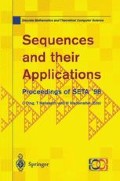Abstract
Examples of d-perfect sequences are constructed based on the method in Xing et al [8]. In particular examples of 1-perfect sequences based on genus 0 curves over binary and the ternary fields are computed, as are 2-perfect binary sequences based on an elliptic curve. The complexity profile of certain of the 2-perfect sequences are experimentally determined to follow that of 1-perfect sequences. Based on two algebraic reformulations of the known characterization of binary 1-perfect sequences, these sequences are proved to be 1-perfect.
Access this chapter
Tax calculation will be finalised at checkout
Purchases are for personal use only
Preview
Unable to display preview. Download preview PDF.
References
Lang, S. Algebraic Number Theory. Second Edition. Graduate Texts in Mathematics, 110. Springer-Verlag, New York, 1994.
Niederreiter, H. “Continued fractions for formal power series, pseudorandom numbers, and linear complexity of sequences.” in Contributions to General Algebra 5 (Salzburg, 1986), 221–233, Hölder-Pichler-Tempsky, Vienna, 1987.
Niederreiter, H. “Sequences with almost perfect linear complexity profile,” in Advances in Cryptology—EUROCRYPT ‘87, D. Chaum and W. L. Price, eds. Springer-Verlag, Berlin: Lecture Notes in Computer Science, vol. 304, 1988, 37–51.
Rueppel, R. A. Analysis and Design of Stream Ciphers. Communication and Control Engineering Series. Springer-Verlag, Berlin-New York, 1986.
Rueppel, R. A. “Stream ciphers,” in Contemporary Cryptology—The Science of Information Integrity, G. J. Simmons, Ed., 65–134, IEEE, New York, 1992.
Silverman, J. H. The arithmetic of ellitic curves, Graduate Texts in Mathematics, 106 Springer-Verlag, New York, 1986.
Wang, M.-Z. and Massey, J. L. The characterization of all binary sequences with a perfect linear complexity profile, Paper presented at EUROCRYPT ‘86, Linköping, 1986.
C. P. Xing and K. Y. Lam, Sequences with almost perfect linear complexity profiles and curves over finite fields, To appear in IEEE Trans. Inform. Theory.
C. P. Xing, H. Niederreiter, K. Y. Lam and C. Ding, Constructions of sequences with almost perfect linear complexity profiles from curves over finite fields, To appear in Finite Fields and Their Applications,1999.
Author information
Authors and Affiliations
Editor information
Editors and Affiliations
Rights and permissions
Copyright information
© 1999 Springer-Verlag London
About this paper
Cite this paper
Kohel, D., Ling, S., Xing, C. (1999). Explicit Sequence Expansions. In: Ding, C., Helleseth, T., Niederreiter, H. (eds) Sequences and their Applications. Discrete Mathematics and Theoretical Computer Science. Springer, London. https://doi.org/10.1007/978-1-4471-0551-0_23
Download citation
DOI: https://doi.org/10.1007/978-1-4471-0551-0_23
Publisher Name: Springer, London
Print ISBN: 978-1-85233-196-2
Online ISBN: 978-1-4471-0551-0
eBook Packages: Springer Book Archive

